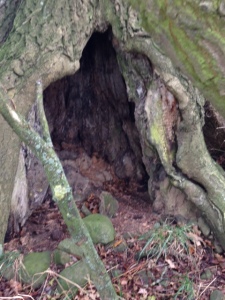 Doctor Who was scanning a London skyline unexpectedly invaded overnight by … forest! Probably not the scene LCI intended to evoke by the phrase “Wild City Retreats”, or by “Stories from the forests of Leeds” . It made a great episode, alongside references to William Blake, Little Red Riding Hood and other archetypal motifs. Had these magical trees appeared to protect us, in the “forests of the night” or were they a terrifying urban alien invasion? As it turned out, they gave screening from a giant solar flare, and the planet was once more saved from extinction.
Doctor Who was scanning a London skyline unexpectedly invaded overnight by … forest! Probably not the scene LCI intended to evoke by the phrase “Wild City Retreats”, or by “Stories from the forests of Leeds” . It made a great episode, alongside references to William Blake, Little Red Riding Hood and other archetypal motifs. Had these magical trees appeared to protect us, in the “forests of the night” or were they a terrifying urban alien invasion? As it turned out, they gave screening from a giant solar flare, and the planet was once more saved from extinction.
.
How aware are you of trees in the urban landscape? Do you listen attentively, quietly and carefully enough to “arboreal coincidences” to gain insight or words from the divine? At November’s Wild City Retreat there was a flash of an idea, as we looked up into a lacy pattern of interlocking boughs, and a social media researcher exclaimed that this pattern looked like drawings of human interaction through the internet: the study of “bio-mimicry”. Could the natural world be an instruction manual for such areas of our life as engineering or the reflecting on the complexity of human relationship?
.
 There are at least three tree-related neighbourhood disputes going on at the moment in my immediate part of the city, and it is likely we will lose yet more of our local green cover. “Wild” and “City” will always struggle to co-exist in our landscape. But through “Retreat” we can at least increase our own awareness of these processes and our responses.
There are at least three tree-related neighbourhood disputes going on at the moment in my immediate part of the city, and it is likely we will lose yet more of our local green cover. “Wild” and “City” will always struggle to co-exist in our landscape. But through “Retreat” we can at least increase our own awareness of these processes and our responses.
.
How can we know trees? Our group all felt pangs of ignorance at not being well versed in common names of growing things around us. But that is to limit ourselves to only one aspect of botanical “knowing”, important though it is. Using alternative identities, such as “eight year old child”, “bird”, “landscape painter” or “property developer”, we found different ways to experience what it is to know and ask questions of a tree.
.
It is suggested that the Celtic calendar held a tree for each month, whose myths and symbolism informed rituals and reflections through the year. We can learn from these fragments of thought, especially as we balance action and passive reflection, community conflict and healing. December’s tree is the rowan, with its flaming  red berries marking the journey of the sun at its weakest point in the year, descending through darkness towards the turning point of winter solstice. We can follow the sun to a personal inner descent, to find a nourishing quiet, still place, hibernating like the animals. Gifts of the heart can be found here, shared around our hearth in the depths of winter. “Only by descending can we glimpse these wonders and reclaim these gifts as our own. In the glitter and shimmer of Christmas we share and honour this treasure… This is why rowan was known as the Tree of Life, because it is in the surrendering, the letting go to life and its dark transitions, that we are enriched and set free.” 1.
red berries marking the journey of the sun at its weakest point in the year, descending through darkness towards the turning point of winter solstice. We can follow the sun to a personal inner descent, to find a nourishing quiet, still place, hibernating like the animals. Gifts of the heart can be found here, shared around our hearth in the depths of winter. “Only by descending can we glimpse these wonders and reclaim these gifts as our own. In the glitter and shimmer of Christmas we share and honour this treasure… This is why rowan was known as the Tree of Life, because it is in the surrendering, the letting go to life and its dark transitions, that we are enriched and set free.” 1.
.
Wild City Retreats are continuing monthly through 2015. Please come and try any of our sessions into the new year, or come monthly.
Follow our progress at www.LCILeeds.org/wild-city-retreats/ and have a look at our evolving resource list for books, networks and ideas.
The next Retreat is the Saturday morning of December 6th and then January 10th, at Meanwood Valley Urban Farm. 9.30 for 10.00 until 12.45.
Time travel is not guaranteed, but we will continue to listen for “arboreal coincidences.”
- “Environmental Arts Therapy and the Tree of Life” by Ian Siddons Heginworth.

